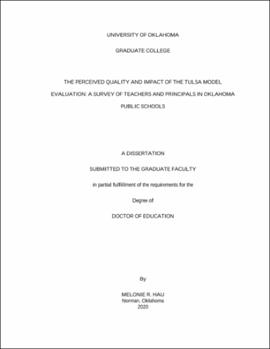| dc.contributor.advisor | Jones, John | |
| dc.contributor.author | Hau, Melonie R. | |
| dc.date.accessioned | 2020-12-17T16:01:56Z | |
| dc.date.available | 2020-12-17T16:01:56Z | |
| dc.date.issued | 2020-12-18 | |
| dc.identifier.uri | https://hdl.handle.net/11244/326633 | |
| dc.description.abstract | Oklahoma began implementing its Teacher Leader Effectiveness Law in 2011, the state’s response to competing for federal Race to the Top grant money and the nation-wide cry from education reformers for tougher teacher evaluation mandates in public schools. This quantitative analysis of variance study explores the effectiveness of the law’s implementation in Oklahoma school districts using the Tulsa Model Evaluation process in the fall of 2019. A guiding theoretical framework for this study is based in the research of Stiggins and Nickel (1989) and Stiggins and Duke (1988) and their findings of the usefulness of the Teacher Evaluation Profile to measure conditions for teacher growth using standards-based evaluation instruments. A cross-sectional survey distributed to principals and teachers gathered perceptions of the quality and impact of the Tulsa Model Evaluation process based on six key areas: knowledge and understanding of the evaluation system; perceptions regarding usefulness; qualifications and evaluator leadership; quality of data and feedback from principals; impact on professional practices; and personal impressions of the evaluation system on professional conversations. The study uses a Welch alternative ANOVA to determine the differences in perceived quality and impact of the Tulsa Model evaluation instrument between principals and teachers in 54 Oklahoma schools. The following research questions were addressed:
1. Do principals and teachers differ in their perceptions of knowledge and understanding of the Tulsa Model Evaluation process and if so, to what degree?
2. Do principals and teachers differ in their perceptions of the usefulness of the Tulsa Model Evaluation process and if so, to what degree?
3. Do principals and teachers differ in their perceptions of the qualification of the evaluator and if so, to what degree?
4. Do principals and teachers differ in their perceptions of the quality of data and feedback in the Tulsa Model Evaluation process and if so, to what degree?
5. Do principals and teachers differ in their perceptions of the impact on professional practices for the Tulsa Model Evaluation process and if so, to what degree?
6. Do principals and teachers differ in their perceptions of the context of professional conversations during the Tulsa Model Evaluation process and if so, to what degree?
Results determined there are significant differences between principal and teacher responses to survey questions with the greatest degree of difference in three key areas: 1. knowledge and understanding of the evaluation; 2. usefulness of the process; and 3. quality of data and feedback. | en_US |
| dc.language | en | en_US |
| dc.subject | Education, Curriculum and Instruction. | en_US |
| dc.subject | Education, Administration. | en_US |
| dc.subject | Education, History of. | en_US |
| dc.title | The perceived quality and impact of the Tulsa model evaluation: a survey of teachers and principals in Oklahoma public schools | en_US |
| dc.contributor.committeeMember | Adams, Curt | |
| dc.contributor.committeeMember | Maiden, Jeffrey | |
| dc.contributor.committeeMember | Houser, Neil | |
| dc.date.manuscript | 2020-12-15 | |
| dc.thesis.degree | Ed.D. | en_US |
| ou.group | Jeannine Rainbolt College of Education::Department of Educational Leadership and Policy Studies | en_US |
| shareok.orcid | https://orcid.org/0000-0003-2359-8888 | en_US |
| shareok.nativefileaccess | restricted | en_US |
